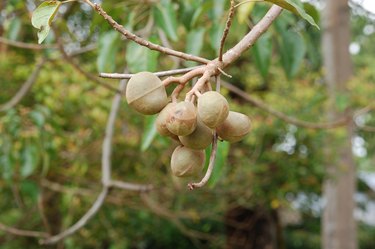
While Hawaii is known for its Lahaina banyan trees and coconut palms, the awe-inspiring candlenut tree (Aleurites moluccanus, USDA plant hardiness zones 10-12) can more than hold up its own against these tropical beauties. Like its tall friends, the candlenut is an evergreen that prefers hot, humid areas, and all three can also grow to be extremely tall.
What Is a Candlenut Tree?
Video of the Day
Initially found in Indonesia, the candlenut now grows in Hawaii, South America and the West Indies. It was designated as Hawaii's state tree back in 1959, and its flower is the island flower for Molokai. This tree goes by several other names, such as the candleberry, Belgaum walnut, Indian walnut, Shi Li Zi and Kukui. It can grow up to 20 to 50 feet tall and 15 to 40 feet wide, with some even possibly growing as high as 90 feet tall. It is a broadleaf evergreen with pale green maplelike leaves, walnut-size fruits and creamy white flowers.
Video of the Day
Kukui has downward-arched branches along with 4- to 8-inch heart-shaped, glossy, triangular to oblong leaves with toothed edges. The younger leaves, flower heads and branches are somewhat fuzzy, and from a distance, this tree can look as though it has fairy dust on it. This fuzzy quality along with the paler leaf color makes these trees stand out from those around them.
The Flowers, Seeds and Leaves
The small flowers bloom from April to October and are beautiful, with five petals packed into clusters. The female ones develop into 2-inch-thick rinded fruits that resemble walnuts. Each fruit has one to two big, nutlike seeds; these are the candlenuts. They have a high oil content, and you can use this oil for many different purposes. If it sounds like it might be tasty, hold off because some say that every part of the candlenut tree is toxic to humans, particularly those seeds. The oils that you can extract can sometimes be consumed without any problems.
Although the oils may be consumable, the leaves aren't. You should never consume the leaves, though they are used in traditional Asian medicine to treat illnesses like headache, inflammation, fever and morning sickness. The leaves may also be used to lower cholesterol and treat sexually transmitted diseases. Practitioners boil down the leaves to extract the essences; the leaves can also be boiled and used as poultices.
How Candlenut Trees Are Used
While candlenut trees are not edible, their seeds, fruits and leaves are used in many different ways. The name candlenut actually refers to the high oil content of the seeds. You can even light up one of the nuts and use it as a light source. Each one will burn for 15 minutes or so, and ancient Hawaiians used them to tell time. The nuts were also strung up on coconut palm fronds and burned one after another.
You can press the nuts in the extraction process to get their oil, which you can then use to light torches. Candlenut oil is also compared to castor oil, and people use it as a massage oil or rub it into their scalp to stimulate hair growth. It dries quickly and is also a popular ingredient used in wood preservatives, paint oils, soap making, linoleum manufacturing and cosmetics. It also has applications as a waterproofing and insulating material and as a rubber substitute.